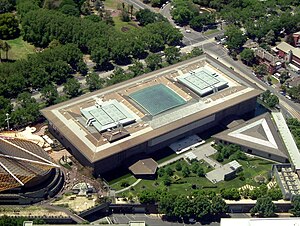National Gallery of Victoria
 |
|
| Established | 1861 |
|---|---|
| Location | Southbank, Melbourne, Australia |
| Coordinates | 37°49′21″S 144°58′07″E / 37.822595°S 144.968634°E |
| Type | Art museum |
| Visitors | 2,600,000 (2015) |
| Director | Tony Ellwood |
| Public transit access |
Flinders Street Station Tram routes 1, 3, 5, 6, 8, 16, 64, 67, 72 |
| Website | http://www.ngv.vic.gov.au |
The National Gallery of Victoria, popularly known as the NGV, is an art museum in Melbourne, Australia. Founded in 1861, it is Australia's oldest, largest and most visited art museum.
The National Gallery of Victoria houses an encyclopedic art collection across two sites: NGV International, located on St Kilda Road in the Melbourne Arts Precinct of Southbank, and the Ian Potter Centre: NGV Australia, located nearby at Federation Square. The St Kilda Road building, designed by Sir Roy Grounds, opened in 1968, and was redeveloped by Mario Bellini before reopening in 2003. It houses the gallery's international art collection and is on the Victorian Heritage Register. Designed by Lab Architecture Studio, the Ian Potter Centre opened in 2002 and houses the gallery's Australian art collection.
Victoria gained independence from New South Wales in 1850, and in the wake of the Victorian gold rush that almost immediately followed, it became the richest colony in Australia, and Melbourne, its capital city, the largest and wealthiest city in Australia. In 1859, the Government of Victoria pledged £2000 for the purchase of plaster casts of sculpture, which were first exhibited on the lower floor of the south wing of the Public Library on Swanston Street on 24 May 1861. Further money was set aside in the early 1860s for the establishment of the first "National Gallery". Grand visions for a gallery building at Lonsdale and Swanston Street were drawn by Nicholas Chevalier in 1860 and Frederick Grosse in 1865 featuring an enormous and elaborate library and gallery, however such visions were never realised.
...
Wikipedia
